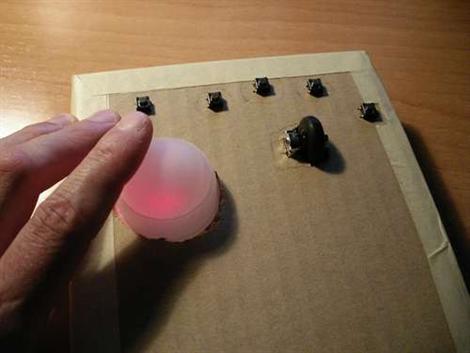
[Elgatoandaluz] has posted this guide on how to tear apart a standard optical mouse and build a custom trackball. He’s using a ping pong ball , mounted above the laser as the trackball itself, which seems like it would be a little lite, but functional. The case is scrap cardboard. We really like that you could toss this together relatively quickly and have a custom layout. He recommends using Sakasa Mouse for inverting the axes and X-control for mapping the buttons(direct download).















Not a ping pong ball, a deodorant roll-on ball with its factory “socket.” Mmm… musky…
What an awesome way to build a trackerball. lovely and cheap!
Just to point out he’s acutally using a roll on deodorant ball.. :P
Use a deodorant ball instead.
Way better.
I had though of this a long time ago. I drew up detailed plans and all. Except my design called for the use of a cue call sitting in a bowl with 3 small bearings to support the cue ball an for smooth action. The bowl itself would be routed into for inserted in a tabletop or in my case X arcade controller with only the upper few mm of cue ball rising above the level on the table top. Make a cover plate with a hole in the middle for the top of the cue ball to poke through and you’ll have a very inexpensive yet strong and heavy trackball. They make marbleized pattern of cue balls too so you can have a neat customized look.
Please don’t post direct download links in your post. If you do at least do us the courtesy of letting us know what the links are.
BTW Nice post keep em coming!
@edward,
good point. editing article.
@rfxcasey
This is almost exactly how the original Logitech Trackman Marble worked, except that the three bearings were more like graphite balls locked in a plastic holder.
@Caleb
see really there is nothing special about the words “X-control for mapping the buttons” and in fact the words “(direct download)” should be the link. Links are suppose to be intuitive.
@chango
Bearings, graphite balls whatever, just something to keep the ball floating with minimal friction.
this is one of those “why didnt i think of that” moments. i am going to rip my girlfriends deodorant apart right now.
I don’t see a laser. Isn’t that just a normal optical mouse? I’m not setting out to be a negativist, but you guys at hackaday really don’t seem to be the technical type. Sorry.
That’s pretty clever right there.
Well done!
This guy is definitely not the first one to think of this. I am not saying I am but I did think of it before him. This is an extremely poor prototype as well. And to the guy talking about the laser. I don’t think it will matter weather you use optical or laser but what you need to think about, and this ping pong ball guy didn’t is that the optical tracks based on differences in the viewed surface. Anything plain and white is not going to track nearly as well as using say a marbleized ball or something with some pattern on it. Also the sampling rate may be an issue as you typically don’t move a mouse as fast as you free spin a trackball especially for arcade games like centipede so you are going to want to get the fasted sampling mouse you can which may be a laser mouse but I good quality optical should work fine just saying. Higher resolution is going to be an improvement too.
Yet another person who’s wanted to build a flipped mouse trackball. If you like trackballs this idea’s pretty straightforward as its the exact design geometry THAT LOGITECH USES, although they do use infrared sensitive CCDs.
Personally I’m only going after this project when I can find a really nice marble or glass sphere of appropriate size, some form of bearings that won’t wear the sphere down, and a glass-sensitive laser mouse decked out with all the buttons and scroll wheels I could want.
It’s really quite sad that this awesome orientation/pointing device is falling out of favor.
@amingham
What if you used a secondary ball under the primary. The secondary would be tracked via laser and could have a pattern on it. The glass ball could sit on top of the secondary ball. With enough weight and friction when you moved the glass ball it would translate to the seconder. That way you could have a perfectly clear glass or crystal ball as the laser would not be looking at it but the translation ball underneath instead.
@rfxcasey
Hmmm, using similar materials as casters/bearings would definitely cut down on wear. By having 3 similar material bearings in a marble mouse config. you could probably keep it nice and snug; but at this point I’m thinking tough, replaceable Teflon pads.
I think by using a secondary ball you run the risk of the two becoming physically disconnected when you flick the trackball to rapidly move the pointer, unless the ball is supported just as well laterally to keep it in-socket.
Woefully incomplete instructions. Yay, Instructables!
A simple solution to the axis problem without extra software or controllers:
The optical mouse have a ccd to detect movement and a fixed lens for focus. Change the focus with an extra lens and put a 45 degree mirror between sensor and ball – so the ccd get a mirror image and change one axis…